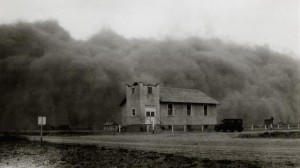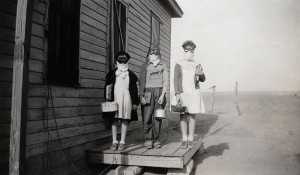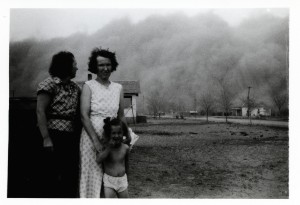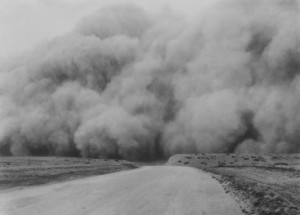A DISASTER WORSE THAN MOST OF US EVER KNEW
In elementary school, for me, “Dust Bowl” was little more than two words that had to be memorized for tests in history classes that unfailingly failed to make history interesting. Sure, I heard the term often enough that some kind of image formed…but it was not until last year, watching old newsreel footage on Turner Classic Movies, that I had a glimpse of the actual devastation. I had succeeded — from what I’d “learned” — in imagining a drought and dried up crops, but this was the first time I saw some of the startling images of what had actually happened.
Although those few seconds of images haunted me for days, it was nothing more than a peek, and I yearned to know more. And now, if you, too, want to experience the full scale of the horror of living in the Dust Bowl, turn no further than the latest Ken Burns documentary, appropriately titled The Dust Bowl. (The two-part, four-hour documentary airs on PBS Sunday and Monday, November 18 and 19, and the DVD will be released the following day on Tuesday, November 20.)
 Fortunately for Ken Burns, the motion picture camera had already been invented by the 1930s, so there is (relatively) ample footage to reveal just how spectacularly destructive the dust was, and how unimaginably miserable it was to live in the midst of it. But be warned: not only is the archival footage entirely in black and white, but the horrific dust storms that plagued the midwestern plains would blacken the entire sky so thoroughly that day became night. As a result, the documentary is often claustrophobic; and if you’re easily depressed, take particular heed. This is a journey into a black Hell; but it is also a very important one to take.
Fortunately for Ken Burns, the motion picture camera had already been invented by the 1930s, so there is (relatively) ample footage to reveal just how spectacularly destructive the dust was, and how unimaginably miserable it was to live in the midst of it. But be warned: not only is the archival footage entirely in black and white, but the horrific dust storms that plagued the midwestern plains would blacken the entire sky so thoroughly that day became night. As a result, the documentary is often claustrophobic; and if you’re easily depressed, take particular heed. This is a journey into a black Hell; but it is also a very important one to take.
What is the Dust Bowl and what caused it? The Dust Bowl became the nickname for the part of the midwest that was affected for a full decade (essentially in alignment with the Great Depression) by a devastating and relentless drought. The illustrious Great Plains was initially a land of plenty: clear blue skies that stretched forever, incredibly fertile soil, and plenty of rain, all of which lured farmers from every direction to plant infinite acres of wheat in Texas, Oklahoma, Kansas, and elsewhere. The problem was, wheat was not indigenous to the land, and the expansion of farming — both in the numbers of farmers and the irresponsible methods of farming — grew literally out of control. After several years of sublime prosperity, the aforementioned drought came along and changed everything. It was bad enough that no rain came year after year, but now farmland stretching through several states was being ploughed but yielding nothing other than dirt. And then the land, to quote one of the experts on hand, “turned against them.”
 When you imagine yourself in the same circumstances, it is almost like a horror movie, but the monster is a literal ocean of dirt. You live in a world where dust is everywhere, every day. Any books you read will have dusty pages. Your dishes and glasses always have to be rinsed before using them, unless you don’t mind eating a little dust (and make no mistake, that’s going to happen whether you mind it or not). You set the table with the plates upside down so that they don’t collect dust while the food is being prepared. The dust is a fine grind, with a consistency like talcum powder. And you can’t escape it. Overnight, a layer of dust will settle all over the room, including on you; when you lift your head in the morning, the spot on the pillow where your head rested will be the only thing not covered with dust. Shielding your face or your bedding with a wet towel or sheet was one way to keep the dust at bay. But there was always more. You can dust the dust away, but it will be back the next day. You’re always breathing it, getting it in your lungs, stuck in your nasal passages. Even if you were born into it, you knew that it was wrong. It creeps into everything. It always finds a way inside your house. You can never escape it. And there is always more coming. It was thought of as pure evil. It was common to lose family members, especially children, to “dust pneumonia.” To say nothing of the money lost and livelihoods ruined. And that’s just day to day life between the dust storms.
When you imagine yourself in the same circumstances, it is almost like a horror movie, but the monster is a literal ocean of dirt. You live in a world where dust is everywhere, every day. Any books you read will have dusty pages. Your dishes and glasses always have to be rinsed before using them, unless you don’t mind eating a little dust (and make no mistake, that’s going to happen whether you mind it or not). You set the table with the plates upside down so that they don’t collect dust while the food is being prepared. The dust is a fine grind, with a consistency like talcum powder. And you can’t escape it. Overnight, a layer of dust will settle all over the room, including on you; when you lift your head in the morning, the spot on the pillow where your head rested will be the only thing not covered with dust. Shielding your face or your bedding with a wet towel or sheet was one way to keep the dust at bay. But there was always more. You can dust the dust away, but it will be back the next day. You’re always breathing it, getting it in your lungs, stuck in your nasal passages. Even if you were born into it, you knew that it was wrong. It creeps into everything. It always finds a way inside your house. You can never escape it. And there is always more coming. It was thought of as pure evil. It was common to lose family members, especially children, to “dust pneumonia.” To say nothing of the money lost and livelihoods ruined. And that’s just day to day life between the dust storms.
Winds picking up dirt was what created the paralyzing dust storms. Residents could see solid black walls of dust far off in the distance descending upon them at 65 miles per hour. And as horrific and terrifying as each dust storm was, the worst part was that it picked up and left behind even more dirt. The degree of dust that piled up on houses, in mounds often as high as the rooftops, was not unlike a snow storm … except it didn’t melt. It just stayed there until you shoveled it out of and off of your house. And what about the acres of farmland? Are you going to shovel all of that as well? Into what?
 What is truly remarkable is the tenaciousness of the people who lived there and, even after years of these terrible conditions, still considered it home. The famous migration to California included a relatively small percentage of people who were escaping the Dust Bowl; and it was only about 25% of the Dust Bowl population itself that left it. Those who did flee to California were in a no-win situation: they were disrespected by the neighbors and family they left behind, and scorned by the native Californians they encountered when they arrived. All migrators — from the Dust Bowl or elsewhere — were derogatorily called “Okies” and (remember that this is the 1930s) their social status was downgraded to the equivalent of blacks; many establishments even segregated the Okies the same way (and into the same segregated locations) as the “coloreds.” The ones who remained behind in the dried-up land had to rely on government assistance (although many refused — they would become the archetypal stoic Americans who were “too proud to accept charity”).
What is truly remarkable is the tenaciousness of the people who lived there and, even after years of these terrible conditions, still considered it home. The famous migration to California included a relatively small percentage of people who were escaping the Dust Bowl; and it was only about 25% of the Dust Bowl population itself that left it. Those who did flee to California were in a no-win situation: they were disrespected by the neighbors and family they left behind, and scorned by the native Californians they encountered when they arrived. All migrators — from the Dust Bowl or elsewhere — were derogatorily called “Okies” and (remember that this is the 1930s) their social status was downgraded to the equivalent of blacks; many establishments even segregated the Okies the same way (and into the same segregated locations) as the “coloreds.” The ones who remained behind in the dried-up land had to rely on government assistance (although many refused — they would become the archetypal stoic Americans who were “too proud to accept charity”).
But with or without direct government assistance, it was indeed the government that restored the land to its former glory. It was a slow but necessary process teaching the farmers an alternative way of sowing the land that didn’t destroy it. The phenomenon of too much farming was also perpetuating the problem, so farmers were actually paid to NOT farm, which allowed the land to restore itself. (The government also bought back a lot of the land for the same reason.) The far-right will certainly see the documentary as a propagandistic treatise promoting government welfare and ringing the warning bells of climate change; and they would not be wrong. It is those damned commies at PBS, after all, with their educational attitude and giving away information for free. But facts are facts: government assistance saved the farmers from complete destitution, and it is an early example of how careless human toiling brought on the unforgiving wrath of nature and — yes, say it with me — climate change. (It’s also a warning that the Great Plains are currently being farmed from a water source that will be depleted in a matter of decades, and a second ferocious Dust Bowl is a very real possibility if a solution is not worked out in time.)
 Interspersed with all of this are personal narratives from survivors who lived through the disaster as children. Ken Burns takes a lot of time with their stories and the intricate details of their lives as a way of weaving human drama into the facts. It’s all part of the very imitable Ken Burns style that you know if you’ve ever seen anything else he’s made: the interviews with experts and eyewitnesses; the monotoned reading of quotes by actors not permitted to act; and most famously, bringing movement and dynamism to a still photograph by panning and zooming in or out of it. (In fact, the Ken Burns style has become so well-known that users of iPhoto have the option of watching slideshows of their photos in “Ken Burns mode” — which makes one wonder how his brother Ric Burns, an equally accomplished documentarian whose style is absolutely identical, feels about it. They are both slavish to their style, to the point that sometimes it makes you want to scream.) And lemme whisper something in your ear: it didn’t need to be four hours. Without the extra padding, it would be a perfect (and even more hard-hitting) two-hour documentary. But to ask a Burns brother to deliver something so brief? Sacrilege! Still, aside from that caveat, the documentary is enthusiastically recommended. The material is fascinating, the collected imagery is rich, and, whether you enjoy the Burns style or not, it’s the most comprehensive documentation of the Dust Bowl that exists.
Interspersed with all of this are personal narratives from survivors who lived through the disaster as children. Ken Burns takes a lot of time with their stories and the intricate details of their lives as a way of weaving human drama into the facts. It’s all part of the very imitable Ken Burns style that you know if you’ve ever seen anything else he’s made: the interviews with experts and eyewitnesses; the monotoned reading of quotes by actors not permitted to act; and most famously, bringing movement and dynamism to a still photograph by panning and zooming in or out of it. (In fact, the Ken Burns style has become so well-known that users of iPhoto have the option of watching slideshows of their photos in “Ken Burns mode” — which makes one wonder how his brother Ric Burns, an equally accomplished documentarian whose style is absolutely identical, feels about it. They are both slavish to their style, to the point that sometimes it makes you want to scream.) And lemme whisper something in your ear: it didn’t need to be four hours. Without the extra padding, it would be a perfect (and even more hard-hitting) two-hour documentary. But to ask a Burns brother to deliver something so brief? Sacrilege! Still, aside from that caveat, the documentary is enthusiastically recommended. The material is fascinating, the collected imagery is rich, and, whether you enjoy the Burns style or not, it’s the most comprehensive documentation of the Dust Bowl that exists.
It might have been a no-brainer to include a mini-documentary about Woody Guthrie among the DVD’s extras, except that his Dust Bowl music is featured so prominently and extensively that it wasn’t really necessary (rent Bound for Glory if that interests you). The DVD extras it does include are: “Uncovering the Dust Bowl;” “A Land of Haze;” “Dust Bowl Stories;” “Grab a Root and Growl;” “The Dust Bowl Eyewitnesses;” and “The Dust Bowl Legacy.” They are primarily expansions of the main feature, all directed or supervised by Ken Burns — long sequences that had to be cut from the final product, presumably. Easily the best of the extras is found on Disc 2, so if you watch only one, make sure it’s “Grab a Root and Growl,” about John L. McCarty, a local Dalhart, TX newsman who ran a paper called The Dalhart Texan. McCarty was a staunch supporter of his region and championed the land through its worst times, becoming an early “spin doctor” before the term was invented. After watching the main 4-hour documentary, you may laugh out loud when you hear his awed description of the majesty and beauty of the dust storms. (The mini-doc ends abruptly and unceremoniously when McCarty moves to another town for a better paying job.)
The Dust Bowl
a documentary by Ken Burns
narrated by Peter Coyote
featuring voiceovers by Carolyn McCormack, Patricia Clarkson, Kevin Conway, and Amy Madigan
approximately four hours on two discs
PBS Distribution
DVD: $24.99
Blu-ray: $29.99
